Top speed 204 km/h Wingspan 35 m Cruise speed 180 km/h First flight June 15, 1960 | Range 430 km Length 33 m Engine type Soloviev D-25 | |
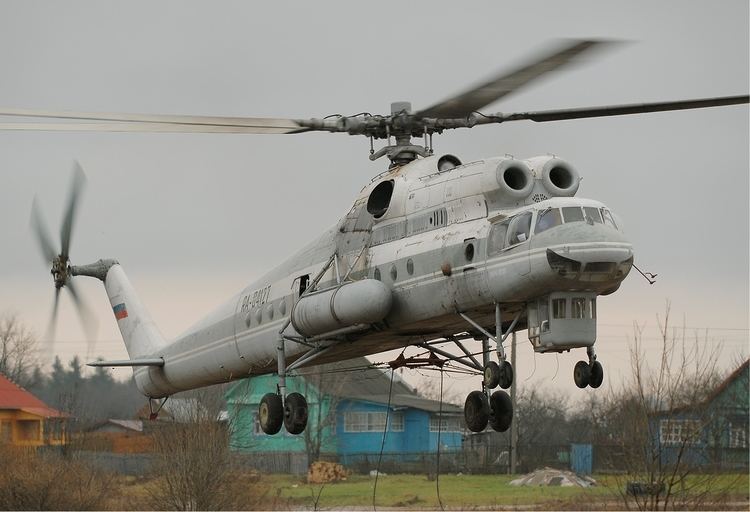 | ||
The largest soviet flying crane helicopter mil mi 10 harke
The Mil Mi-10 (NATO reporting name Harke), given the product number izdeliye 60, is a Soviet military transport helicopter of flying crane configuration, developed from the Mi-6, entering service in 1963.
Contents
- The largest soviet flying crane helicopter mil mi 10 harke
- Mil mi 10 skycrane hd
- Design and development
- Mi 10K short legged version
- Operational service
- World records
- Variants
- Operators
- Former operators
- Specifications Mi 10
- References
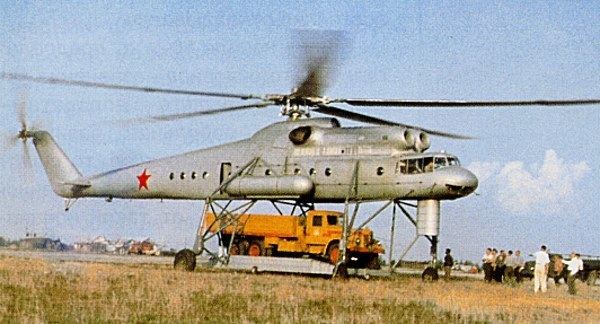
Mil mi 10 skycrane hd
Design and development
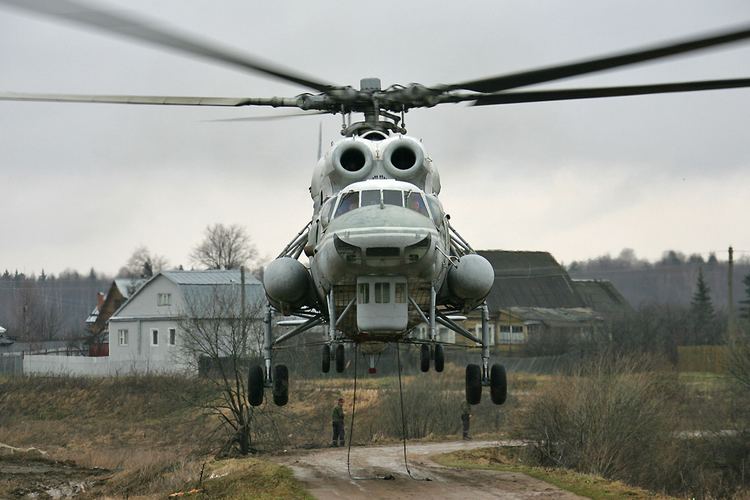
The advent of the Mi-6 gave the Soviet Union the very useful ability to move and place large, bulky or heavy loads with precision. Limitations of the Mi-6 in the flying crane role included a weight to payload ratio and the inability of the crew to easily see the load and its intended final position. A Council of Ministers directive of 20 February 1958 tasked OKB-329 (OKB Mil) with the development of a dedicated flying crane helicopter for carrying bulky loads unable to be carried in the hold of a Mi-6.
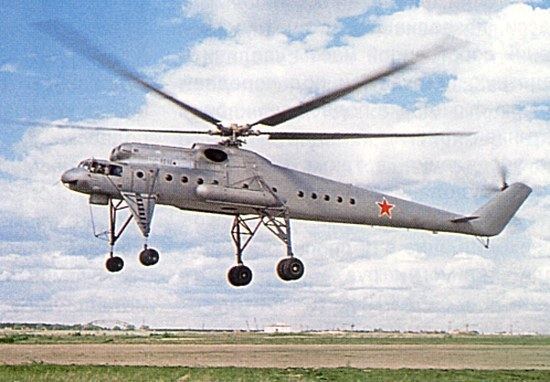
The Mil OKB's response drew heavily on the Mi-6, utilising the dynamic components and 4,100 kW (5,500 hp) Soloviev D-25V turboshaft engines, on a slim fuselage sitting on four tall strut braced undercarriage legs, with a wide track allowing the helicopter to taxi over loads, or for mobile loads to be moved underneath. The fuselage can carry 28 passengers inside the cabin as well as 3 t (6,600 lb) of cargo loaded through a side door in the aft fuselage, by an integral boom and winch. Underslung loads can be attached directly to the fuselage by hydraulically operated clamps, or carried on a 8.5 m × 3.6 m (28 ft × 12 ft) pallet lifted by the winch and braced by cables and/or struts to the undercarriage legs. The external sling system, with a capacity of 8 t (18,000 lb), of the Mi-6 could also be fitted under the centre fuselage.
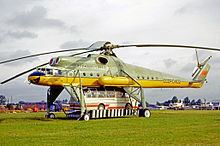
The first prototype V-10 emerged with canted main undercarriage legs with single wheels on all four legs, as well as a retractable emergency escape chute extending below the cockpit and external auxiliary fuel tanks either side of the centre fuselage. As development progressed the main undercarriage legs were replaced with vertical units carrying twin wheels, twin nose undercarriage wheels after a period retaining the single wheels, an Auxiliary power unit (APU) installed behind the cockpit on the starboard side and emergency escape slide cables for use when the pallet is carried.
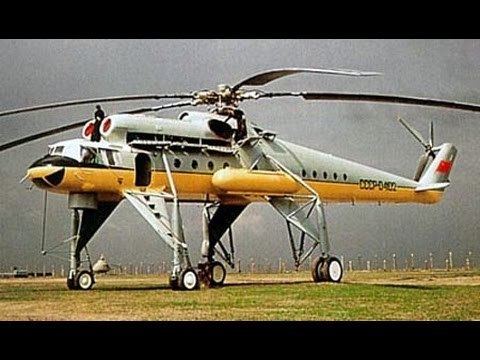
The first prototype V-10 was completed in 1959 and was soon officially allocated the service designation Mi-10. The first flight took place on 15 June 1960 and flight testing continued successfully until in May 1960 the first prototype crashed during a precautionary landing resulting from loss of gearbox oil pressure, only the Navigator/ radio operator surviving. After joining the flight test programme the second prototype began a series of world record breaking altitude/payload flights for turbine powered helicopters. State acceptance trials were passed successfully in 1961, but production did not commence until 5 March 1964 at the Rostov-on-Don factory, with first flight of a production aircraft on 10 September 1964, leading to a total of forty of the long-legged Mi-10 helicopters built, from 1964 to 1969.
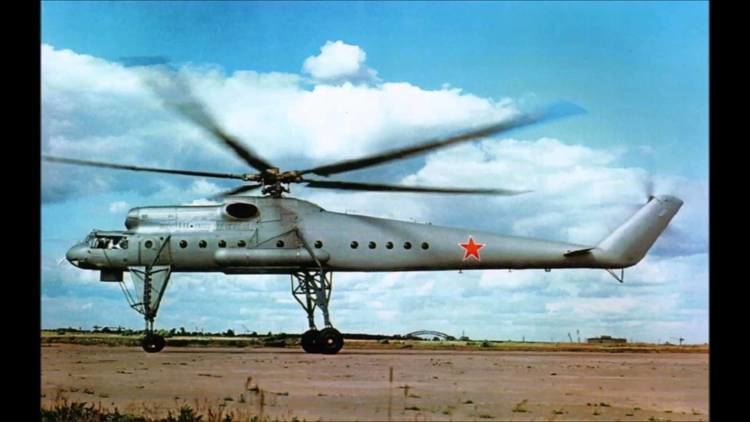
An early production Mil Mi-10 was exhibited in western Europe for the first time at the June 1965 Paris Air Show at Le Bourget Airport.
Mi-10K (short legged version)
The limitations of the Mi-10 in the slung load mission soon became obvious, chiefly, the loss of payload due to the heavy and complicated undercarriage, and more importantly the almost complete lack of oversight of the slung load, despite the inclusion of a CCTV (closed circuit television) system intended for observation of slung loads.
Foregoing the requirement to carry palleted or podded cargoes, Mil redesigned the Mi-10 with a much shorter, fixed, four-leg undercarriage and replaced the extendible escape chute with a gondola fitted with flying controls for a pilot to fly the aircraft during slung load operations. The remainder of the aircraft is essentially identical with the long-legged version. Seventeen of the new flying crane were produced as the Mi-10K, including two conversions from Mi-10s from 23 March 1974 to 1977.
Operational service
The operational service of the Mi-10 was of moderate success, being distributed mainly to units of the VVS (Voyenno-Vozdushnyye Sily - Soviet Air Force) which already operated the Mi-6. Operations with no load were found to be unstable, and the best procedure for take-off was found to be a rolling take-off, which usually also resulted in nose-wheel shimmy when lightly loaded. The main mission of the early Mi-10 virtually evaporated with the improvements in contemporary ballistic missiles; thus the majority of the long-legged variants were converted to Mi-10PP, (or mi-10P), airborne Electronic Counter-Measures helicopters, carrying a large ST-900 Step' (Step' - Steppe) ECM pod under the fuselage mounted on a pallet.
Other Mi-10 long legged aircraft were converted to carry out a wide variety of missions but usually only as single prototypes. Of special note was the Mi-10R (R - recordnyy- record) record breaking helicopter, converted from a production machine, with the undercarriage of a Mi-6 fitted with fairings and spats, as well as a tail bumper to reduce the risk of damage to the rear fuselage on landing.
World records
Data from:Mil's heavylift helicopters : Mi-6, Mi-10, V-12 and Mi-26 The Mi-10R has held seven world records, none of which are still current, in the FAI E1 General class for rotorcraft powered by turbine engines.
Variants
Operators
Former operators
Specifications (Mi-10)
Data from Jane's All The World's Aircraft 1975-76 & Mil's heavylift helicopters : Mi-6, Mi-10, V-12 and Mi-26
General characteristics
Performance
